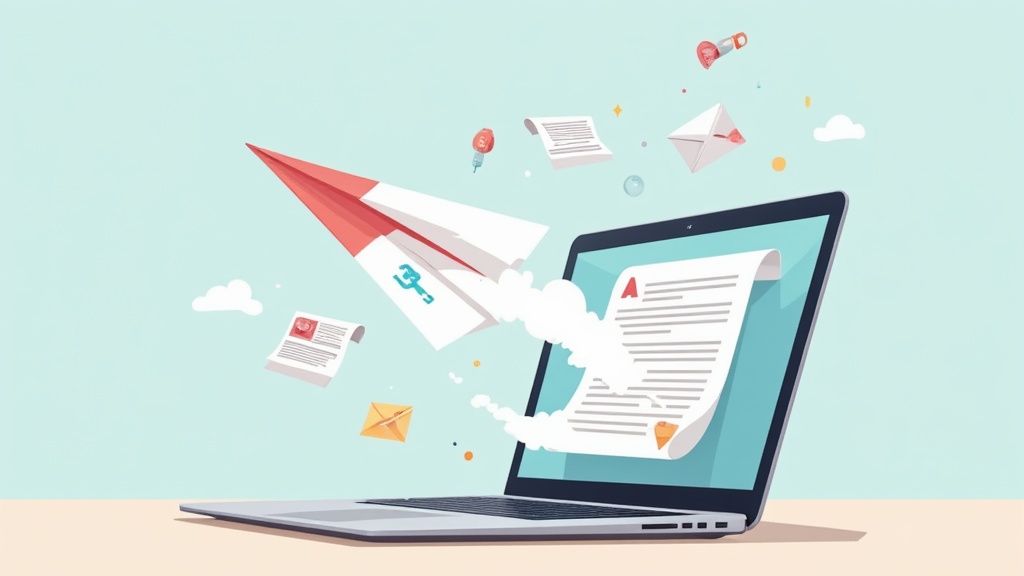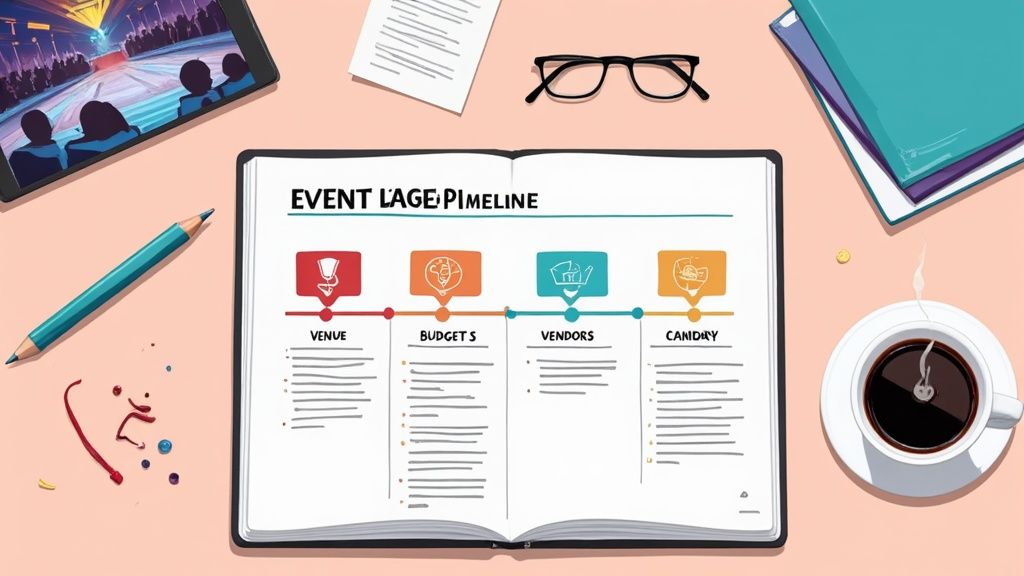An event media release is pretty straightforward: it's an official statement you send to the media to announce an upcoming event. It covers all the essential details - the who, what, where, when, and why. Think of it as your first and most powerful tool for drumming up press coverage, building credibility, and creating a real buzz before your event even kicks off.
Why Bother With a Media Release Anymore?
In a world drowning in digital noise, you might be wondering if a "traditional" document like a media release still has a pulse. The answer is a hard yes. I've seen it time and time again. It’s not just an announcement; it's your official handshake with the press and, by extension, the public. It’s the one piece of content that makes your event legitimate in the eyes of a journalist.
A well-crafted release does way more than just list facts. It frames the entire narrative. This is your chance to control the story from the get-go, shine a spotlight on the most compelling parts of your event, and establish why it's so important.
For example, a release for a local charity run isn’t just about a date and time. It’s about the community impact, the personal stories behind the runners, and a shared goal everyone can get behind. That's the story you want to tell.
Building Credibility and Generating Buzz
Honestly, this single document can be the difference between a sold-out conference and an embarrassingly empty room. It signals to media outlets that your event is a professional, newsworthy affair worth their time - and their audience's. That kind of credibility is priceless.
A strategically timed event media release doesn't just inform; it creates momentum. It acts as a catalyst, sparking conversations and securing media spots that amplify your reach exponentially, laying the groundwork for a successful event.
You really can't overstate the value of this initial push. With the global event industry projected to hit $2.5 trillion by 2035, standing out is everything. A powerful release is a crucial piece of your overall strategy, making sure you capture attention right from the start. It's just one part of building a complete event marketing plan, but it’s a foundational one.
The Bottom-Line Impact
When it comes down to it, a strong event media release connects directly to your brand’s reputation and your bottom line. Research shows that two-thirds of attendees feel more positive about a brand after an event. Getting those attendees in the door is paramount.
Your release is the very first step in that journey. It turns a simple announcement into a core part of your marketing arsenal, setting the stage for building real brand affinity and a successful event.
The Anatomy of a Media-Friendly Release
If you want your event to get noticed, you have to stop thinking like a marketer and start thinking like a journalist on a deadline. They're drowning in pitches and don't have time for fluffy, jargon-filled announcements. They need the facts, and they need them yesterday.
Let's break down how to build a release that a journalist will actually read and use. Every piece, from the headline to the last line, has a job to do.
It all starts with a headline that’s both punchy and informative. It needs to tell the core story in a single glance. Forget something generic like "Tech Innovators Conference Announced." That's a one-way ticket to the trash folder.
Instead, go for something with impact: "Tech Innovators to Unveil AI-Powered Sustainability Solutions at Annual Summit." See the difference? It's specific, packed with keywords, and hints at something genuinely newsworthy.
The Critical First Paragraph
Your opening paragraph is your make-or-break moment. You absolutely have to nail the five Ws - Who, What, When, Where, and Why - right out of the gate. A busy journalist should be able to get everything they need for a quick news brief from this paragraph alone.
Keep it lean and direct. Always start with the dateline (e.g., "SAN FRANCISCO – October 26, 2024 –"). Then, launch straight into the most critical information. This isn't the time for flowery prose; it's for hard, verifiable facts.
From drafting the perfect release to getting it into the right hands, the process is a straightforward but crucial sequence of steps.
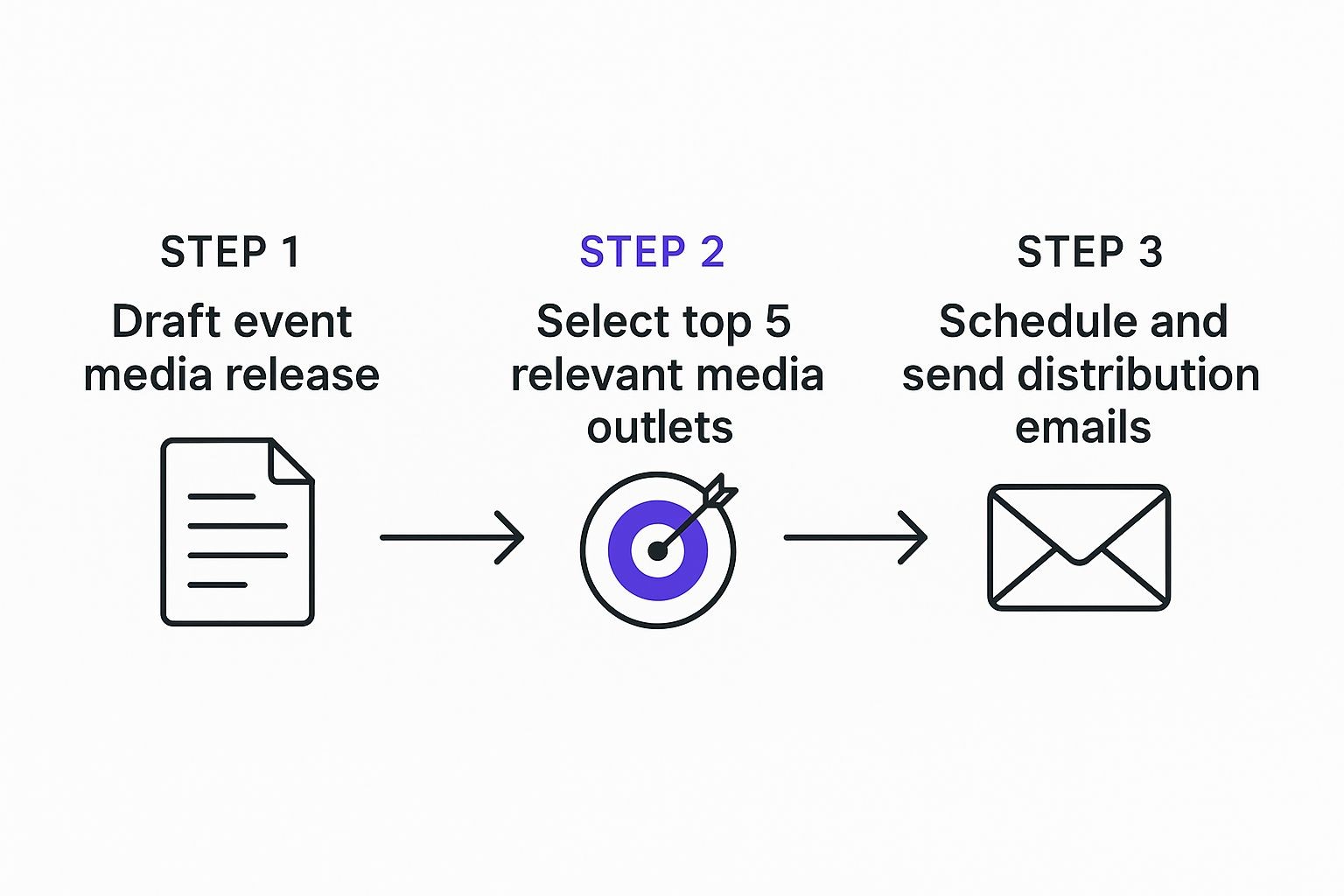
This just goes to show that great writing is only half the battle. Your success hinges just as much on smart, targeted distribution.
Core Elements of a Professional Event Media Release
To make sure your release looks professional and provides all the necessary information, you need to include a few standard components. Here’s a quick rundown of what every solid event press release should contain.
| Component | Purpose | Pro Tip |
|---|---|---|
| Headline | Grab attention and summarize the core news. | Use action verbs and include specific, compelling details. |
| Dateline | Indicate the release's origin city and date. | Format it consistently: CITY, State – Month Day, Year – |
| Introduction | Answer the 5 Ws (Who, What, When, Where, Why). | Write it so a journalist could use it as a standalone summary. |
| Body Paragraphs | Provide supporting details, context, and background. | Keep paragraphs short (2-3 sentences) and focused. |
| Quotes | Add a human voice and expert perspective. | Avoid generic excitement. Offer a unique insight or a bold statement. |
| Boilerplate | Give a brief overview of your organization. | Keep it standardized and reuse it across all your press releases. |
| Media Contact | Provide contact info for follow-up questions. | List a real person who can respond to inquiries quickly. |
| ### | Mark the end of the release. | This is a traditional signal that the press release is finished. |
Getting these elements right shows journalists you understand how things work and respect their time, which instantly boosts your credibility.
Adding Depth with Quotes and Boilerplates
Once the essential facts are on the page, it's time to add some color and authority. This is where a killer quote comes in handy. It breathes life into the release, giving it a human touch and an expert opinion a journalist can lift directly for their story.
Please, avoid saying things like, "We are excited to host this event." It’s a wasted opportunity. Instead, give them something with substance, like: "This summit isn't just another conference; it's a critical forum for tackling the $1 trillion challenge of supply chain inefficiency with actionable AI strategies."
Now that's a quote a journalist can work with. It provides context, shows authority, and includes a compelling statistic.
Finally, you’ll wrap things up with two essential sections:
- About Us: This is your boilerplate, a short, standard paragraph about your organization. It tells journalists who you are and establishes your credibility.
- Media Contact: Make it ridiculously easy for a journalist to reach you. Include a name, email, and phone number for someone who can actually answer questions and schedule interviews promptly.
By tailoring each of these components, you elevate your announcement from a simple document to a powerful PR tool. You're not just sending information; you're making a journalist's job easier, which is the fastest way to get the coverage your event deserves.
Crafting a Compelling Event Story
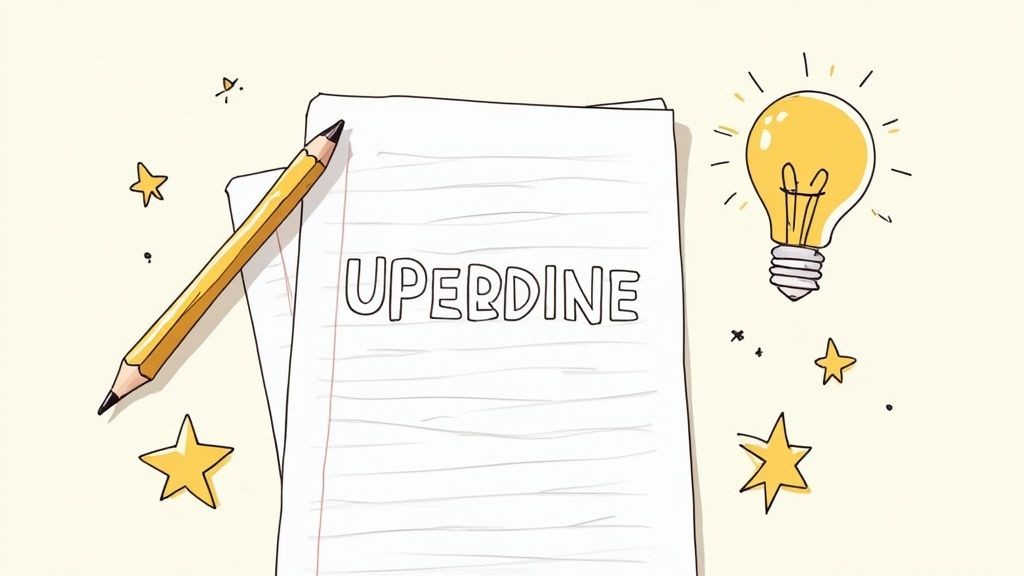
Here’s a hard truth: facts get your event media release opened, but it’s the story that gets it published. Journalists are absolutely inundated with announcements. What they're really hunting for are narratives - stories that will actually connect with their audience.
Your job is to dig past the basic logistics and find that one unique, newsworthy hook. This is what separates a simple announcement from a story a reporter can sink their teeth into.
So, what makes your event more than just another date on the calendar? Is it a big-name speaker, a wild new technology reveal, or maybe a heartfelt charitable partnership? That's your angle.
For instance, pitching a "local tech meetup" is instantly forgettable. But what if you pitched it as a meetup where "local students will unveil an app designed to help senior citizens with daily tasks"? Now that's a story. It has community impact, it has a human element, and it’s something a journalist can build a real feature around.
Finding Your Newsworthy Angle
To find that killer angle, you have to step outside your own bubble. Forget what you think is important for a second. What would make a complete stranger stop scrolling and pay attention?
Get your team together and brainstorm every single unique thing about your event. Ask some tough questions:
- Is there a human-interest element? Are you honoring a local hero? Does the event support a cause people genuinely care about?
- Is there a conflict or a problem being solved? Maybe your event tackles a huge industry challenge or a pressing community issue head-on.
- Is there anything novel or exclusive? Will people see something for the very first time? Think product launches or a never-before-seen performance.
Once you have a few potential hooks, put them to the test. Which one has the most emotional punch? Which one has the broadest appeal? Often, the strongest angle links your event to a bigger trend, a community need, or something that's already buzzing in the news.
It's also worth remembering that media attention is a double-edged sword. Understanding the impact of media coverage can help you frame your narrative in a way that generates positive buzz, not panic or misunderstanding.
Avoiding Common Storytelling Pitfalls
Finding a great hook is half the battle. The other half is not messing it up. So many promising media releases die a quiet death because they're choked with jargon, tired clichés, and self-serving fluff. Journalists can spot this from a mile away and the delete button is their best friend.
The fastest way to lose a journalist's interest is with corporate-speak and empty adjectives. Phrases like "world-class experience" or "synergistic solutions" mean nothing. Instead, provide concrete details and specific outcomes that demonstrate your value.
Your goal is simple: make your story easy for a busy reporter to understand and even easier for them to pitch to their editor. A clear, authentic narrative is your single greatest asset.
Here are a few classic traps to sidestep:
- Making it all about you: Don’t just drone on about how great your company is. The story isn't you. The story is the value you're providing to attendees and the wider community.
- Falling for hyperbole: Ditch the superlatives like "best," "greatest," or "most amazing." If your event is truly that great, the facts and the story will prove it without you having to shout it.
- Burying the lede: This is a cardinal sin. Your most compelling angle needs to be right there in the headline and the first sentence. Don't make them hunt for it.
By zeroing in on a genuine, powerful story and ruthlessly cutting the fluff, your event media release will do more than just inform. It will capture attention and give reporters a narrative they’re actually excited to share.
Getting Your Release into the Right Hands
So, you’ve crafted the perfect media release. That’s great, but it’s completely worthless if it just sits in your "sent" folder, unread. The next, absolutely critical step is getting it into the hands of journalists who can actually bring your story to life.
Forget the old "spray and pray" method of blasting your release to a generic list. That’s a surefire way to get your email address flagged as spam. Smart distribution is all about precision, not volume.
Your first job is to build a highly targeted media list. This isn't just a random collection of email addresses. It's a carefully curated directory of specific reporters, editors, and bloggers who have a proven track record of covering your industry or events in your local community.
Think about it: sending a tech conference release to a food blogger is a waste of everyone's time. Instead, use tools like social media, journalist databases, or even just good old-fashioned reading of your target publications to pinpoint the right people. Jot down their names, where they work, and the specific topics they're passionate about.
Choosing Your Distribution Channel
Once you have your list, you need to decide how to actually send your media release. You have two main paths: using a newswire service or doing direct, personalized outreach. Each has its own set of pros and cons, and the right choice really depends on your goals and budget.
- Newswire Services: Platforms like PR Newswire or Business Wire can distribute your release to a massive network of media outlets. This is fantastic for getting broad reach and can even give your SEO a little boost. The downside? It's often impersonal and can get pretty expensive.
- Direct Email Pitching: This is my preferred method, hands down. It means sending a personalized email directly to the journalists on that list you so carefully built. It definitely takes more effort, but it allows you to build genuine relationships and tailor your pitch to what they actually care about. This dramatically increases your chances of getting noticed.
A personalized email pitch that references a journalist's recent article or specific beat is 10x more effective than a generic blast. It shows you've done your homework and respect their work, which is the foundation of any good media relationship.
The Art of the Perfect Pitch and Follow-Up
Your email pitch is not the press release itself. Think of it as the cover letter that convinces someone to open the main document. Keep it incredibly brief and straight to the point.
Your subject line needs to be compelling enough to stand out in a crowded inbox. The body of your email should then summarize the most newsworthy angle in just a few powerful sentences.
Always paste the full press release into the body of the email - never, ever send it as an attachment that can get flagged by spam filters. It’s also a great idea to link to your online media kit.
Then comes the waiting game. Professional follow-up is a delicate dance. Give it about two to three days, then send a single, polite reply to your original email. Something simple like, "Just wanted to gently follow this up and see if you had any questions," is often all it takes. If you don’t hear back after one follow-up, it’s best to let it go and move on.
Mastering distribution is just one piece of the promotion puzzle. For a broader view, check out these top event promotion ideas to boost attendance. Beyond just media outreach, you can also explore more effective content distribution strategies to get your message out there even further.
Using Timing and Tech to Your Advantage
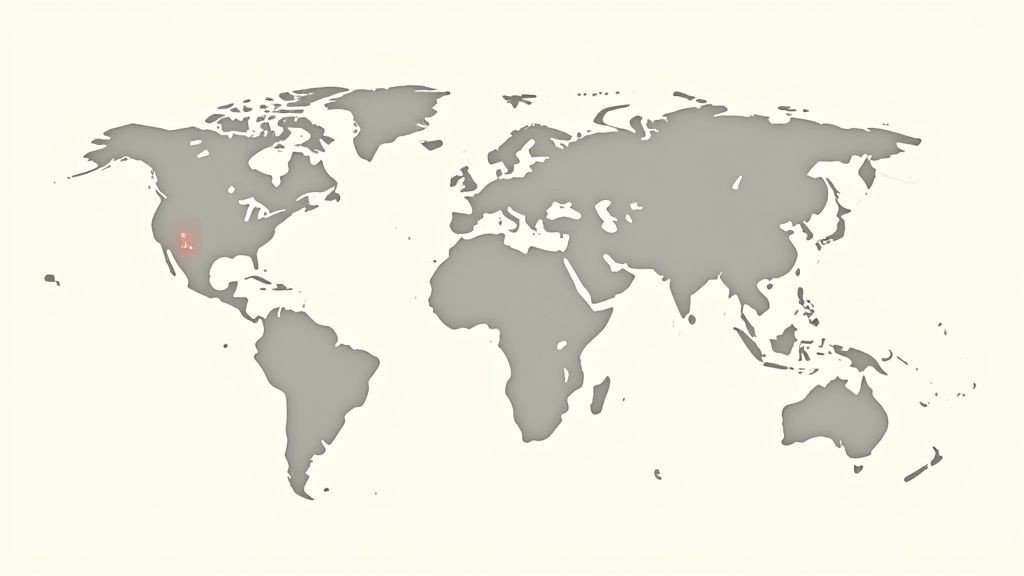
In today's fast-moving media world, a single, perfectly crafted media release is just the opening act. If you really want to grab - and keep - attention, you need to get smart with your timing and the tech you use. This one-two punch turns your announcement from a one-off email into a full-blown campaign that builds serious momentum.
Think of your release schedule less as a single date and more as a strategic sequence. The real goal is to create multiple touchpoints that keep your event on people's radar without just becoming background noise. It's a multi-stage approach that ensures you hit journalists and potential attendees at exactly the right moments.
This is more important than ever. Around 74% of event marketers see their budgets growing, and 66% are planning to host more events. To handle this boom, 24% of event professionals are turning to technology to get an edge. A tech-savvy outreach plan is no longer just a nice-to-have; it's essential. You can dig into more event industry statistics and trends to see just how much tech is shaping the game.
Building Your Release Cadence
A well-paced release schedule keeps your event in the spotlight. This isn't about spamming people with the same document over and over. It's about creating new, legitimate reasons to talk.
A solid cadence I've used successfully looks something like this:
- The Big Announcement (4-6 weeks out): This is your main event media release. It breaks the news, sets the scene, and gives journalists all the core details they need for that first story.
- The Mid-Campaign Nudge (2-3 weeks out): Find a newsworthy hook. Did you just land a major speaker? Announce a key sponsor? This gives you a fresh angle and a reason to get back in touch.
- The Final Reminder (3-5 days out): Send out a short, punchy "media alert." This is a quick rundown of logistics and any last-minute compelling details. It's perfect for getting into last-minute news segments or calendar listings.
- The Post-Event Wrap-Up (1-2 days after): So many people skip this step, and it's a huge missed opportunity. A post-event release shares key results, powerful photos, and thank-yous. It cements the event's success and tees you up for next year.
Here's a pro tip: Treat your post-event release with the same urgency as the initial announcement. It’s your chance to lock in your event's reputation, show stakeholders tangible results, and hand media outlets a positive follow-up story they can run with.
Leveraging Technology for Smarter Outreach
Trying to manage all this by hand is a quick way to get overwhelmed. This is where modern PR and event software becomes a lifesaver. These tools do a lot more than just send emails; they streamline your entire workflow.
For example, platforms can help you build and manage targeted media lists, track who’s opening your emails, and see which journalists are actually clicking your links. This data is gold. It lets you focus your follow-up efforts where they'll make the biggest difference.
Simple tech also makes personalization possible at a scale that used to be a fantasy. Using email templates with custom fields, you can reference a journalist’s specific beat or a recent article they wrote. It's a small touch, but it shows you've done your homework and dramatically increases your chances of getting a reply. A well-timed, tech-powered outreach plan isn't just an advantage anymore; it's a core part of any successful event media release strategy.
Your Event Media Release Questions Answered
Even with the best game plan, a few questions always pop up when you're in the weeds of writing a media release. I get asked these all the time, so I've put together some quick, real-talk answers. Let's clear up any confusion so you can get that release out the door.
What Is the Ideal Length for an Event Media Release?
Think concise. You want to aim for around 400-500 words. That's the magic number that usually keeps it to a single page, which is a huge sign of respect for a journalist's time. They should be able to scan it and get the whole story without endless scrolling.
The real heavy lifting should be done by your headline and your opening paragraph. Nail those, and you've covered the essentials. If you have a ton of extra info - like detailed speaker bios or complex schedules - don't cram it in. Just link out to your event's landing page or a dedicated online media kit.
When Is the Best Time to Send a Media Release?
Timing can genuinely make or break your efforts. The sweet spot is almost always mid-week. Think Tuesday, Wednesday, or Thursday. I always tell people to avoid Mondays (everyone's digging out from a weekend email avalanche) and Fridays (people are already thinking about their weekend plans).
As for the time of day, try to hit their inbox between 9 AM and 11 AM in their local time zone. This is the golden window when reporters are mapping out their day's stories but before the chaos of deadlines and meetings takes over.
One of the biggest mistakes I see is sending a release way too close to the event. For a big launch, give reporters at least two to four weeks' notice. For a smaller, more straightforward media alert, three to five days is usually enough runway.
Should I Include Photos or Videos?
Yes, absolutely. A press release with good visuals gets way more attention than a wall of text. A few high-quality photos or a link to some B-roll video can be the single thing that convinces a journalist to cover your story over someone else's.
But here's the crucial part: never attach large files directly to your email. That's a one-way ticket to the spam filter and a surefire way to irritate a busy reporter. The pro move is to host all your assets - your high-res images, logos, and videos - in a cloud folder on Google Drive or Dropbox. Then, just pop a clean, clearly labeled link to your "media kit" right in the release.
How Do I Follow Up Without Being Annoying?
Patience is a virtue here, seriously. After you send the initial pitch, give it at least two to three business days before you even think about following up. When you do, a gentle nudge is all it takes.
Just reply to your original email with a short, polite message. A simple "Just wanted to check if you had a chance to see this" works wonders. If you can add a small new piece of information or a fresh angle, even better. If you still hear crickets after one follow-up, it’s probably time to let it go. And whatever you do, don't call them unless you already have a relationship. This respectful approach builds your credibility for the long haul.
Getting your communications right is just as important as managing confirmations after a great "Save the Date" blast. For more on that side of things, check out these tips on how to handle your Save the Date and RSVP process.
Make every event unmissable. With Add to Calendar PRO, you can create beautiful, reliable Add to Calendar buttons and manage RSVPs with ease, ensuring your audience never misses an important date. See how it works at https://add-to-calendar-pro.com.
